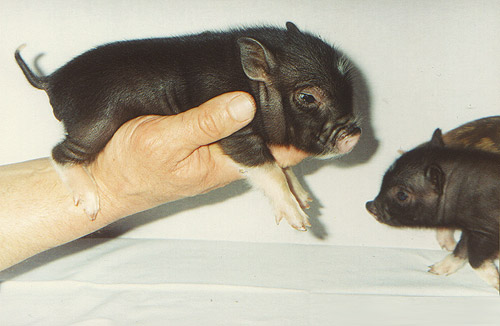
Minipig (Sus scrofa domesticus minipig)
Phylum —chordata
Class — mammalia
Order — artiodactyla
Family — suidae
Genus – sus
Miniature pig is used to refer to small breeds of domestic pig, such as Vietnamese Pot-Bellied pigs, Göttingen minipigs, Juliana pigs, Choctaw hogs, Pennywell miniature pigs or Kunekunes (and specimens derived by crossbreeding with these breeds).
Appearance
Notable features of most miniature pigs distinguishing them from other pigs may be defined by their possession of small, perked-back ears, a pot belly, a swayed back, a chubby figure, a rounded head, a short snout, short legs, a short neck and a short tail with thick hair at the end. Typically, most breeds of miniature pigs will range from the minimum weight of 50 pounds (23 kg) to 200 pounds (91 kg).
Origin
In the early 20th century scientists bred together several lines of existing pigs in selective breeding programmes, mainly for laboratory purposes. Over the years many breeds were crossed which resulted in pigs of smaller sizes than their predecessors.
Behavior
Miniature pigs are intelligent creatures. Unfortunately, miniature pigs can also be aggressive creatures, especially if they aren’t disciplined properly and consistently from a young age. This aggressive behavior can lead to biting, among other issues, that no individual or family should have to deal with.
Aggressive behavior usually doesn’t occur because your pig is upset or angry at you but because they are trying to assert their dominance in the household.
Diet
A mini pig's diet should consist primarily of grains and leafy greens and of up to 12% protein. Fruit can be given in moderation as treats.
Pigs are omnivores, so they are likely to eat nearly everything that comes their way, but that does not mean they should.
A balanced diet for a pig is one that doesn’t make it gain weight and is made mainly from commercial food pellets and healthy greens.
Reproduction
Sexual behavior begins very early in pigs—before weaning—and can include unpredictable behavior, aggression, rooting, as well as mounting and destructive behaviors. Intact pigs can be difficult to house train.
Females can display cyclic moodiness, mounting, and urinary marking every 21 days or so.
Intact males display behaviors, such as kneading the ground (similar to a cat), mounting, and intense foaming at the mouth (unrelated to anticipation of food), as well as frequent vocalizations or “huffing” noises.Gestation lasts 112-116 days. Litter size: average 6-8, range 2-15.
Life expectancy – 14-21 years (average 15-18).
In captivity
Some aspects of the urban environment are not compatible with keeping pet pigs. While, in some ways, pigs are similar to dogs – they can be house-trained, for instance – they have other needs that are difficult to meet in a home setting.
Pigs are very curious animals, and enjoy an environment where they can explore, root around with their snouts and manipulate objects. Some dog toys are not an appropriate choice for pigs, as pigs can often easily destroy and consume them, which poses a risk to their health. Other objects in your home may be the target of their curiosities as well. Suitable pig toys include anything that can be manipulated but not easily destructible, safe if consumed, and provides a challenge or results in a reward (e.g. a food treat) when the pig plays with it.
Without opportunities to perform normal pig behaviors, pigs will become bored and create their own fun in the house, often by rooting through cupboards, tearing apart couches and knocking over tables. Pigs are best suited to an outdoor environment that provides them with lots of space to carry out these activities safely.
Outdoors, you will need to provide them with shelter, as pigs are susceptible to cold and hot temperature extremes. Many people are unaware that pigs don’t sweat, they are prone to insect bites and parasites and they can get sunburnt. A wallow (i.e. a shallow mud pit) is very beneficial. It cools them off on hot days, and acts as an insect repellent, sun screen and skin conditioner, as pigs are prone to dry, flaky skin.
Appropriate fencing must be used to enclose their outdoor area, as pigs are very strong and can uproot it, push it over and even dig underneath it if not properly secured. You will also need to consider protecting your pig from predators like coyotes, wolves, big cats, bears, or even loose dogs.
One final thought to consider is how your pig will be housed and cared for while you are away from your home for extended periods of time.
 Russian
Russian
 English
English
























